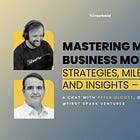Welcome to the 75th edition of Deep Tech Catalyst, the channel by The Scenarionist, where science meets venture!
This is Part Two of our special MedTech miniseries with Peter Olcott, Deeptech Principal at First Spark Ventures!
If you missed Part One, we explored the core business models in medical technology, how to engage KOLs from the earliest stages, and why capital-intensive startups must treat investors as their first true customers.
Today, we pick up right where we left off—with a deep dive into what it really takes to scale a capital-intensive MedTech startup: from margin dynamics and pricing strategies to sales team structure, crossover investors, and the rise of hybrid service models in preventive care.
This second episode continues the same masterclass tone—no fluff, no theory, just real-world frameworks and strategic insight from someone who’s done it at scale.
Let’s dive in. 🚀
✨ For more, see Membership | Deep Tech Briefing | Insights | VC Guides
BEYOND THE CONVERSATION — REFLECTIONS & STRATEGIC INSIGHTS FROM THE EPISODE
The Economics of High-CapEx MedTech Companies
Once a capital-intensive deep tech company reaches the phase where its machines are operational and deployed, it enters one of the most stressful stages of its lifecycle. At this point, capital is often limited, and the company must balance maintaining functional machines with scaling operations, without running out of cash.
Think of company economics as an amplifier: money in, money out.
The goal is to generate more in sales than the capital raised. For example, if a company raises $30 million, it would aim for a return of 2 to 3 times that amount. This means turning that capital into $100 million in revenue, which requires strong unit economics and scalable operations.
At the core of this capital efficiency equation is margin structure.
Specifically, venture investors typically look for 85% gross margins on hardware products. That is, the total cost of components, manufacturing, assembly, installation, and user training should amount to no more than 15% of the sales price.
When this threshold is met and when operating expenses are controlled, a company can reach 15% operating margins—a level of profitability that signals readiness for a public offering.
In practice, however, many companies fall short of this goal.
Early on, gross margins might sit closer to 55% or 75%, which can result in negative operating margins. A 55% gross margin could translate to a -15% operating margin, meaning a company generating $100 million in revenue is still losing $15 million annually.
Moreover, as each new sale demands additional manufacturing, staffing, and support, negative margins make the model harder to scale without raising additional capital.
Challenges with Scaling High-CapEx Models
The very nature of high-CapEx businesses introduces structural difficulties in scaling profitably. Every unit sold requires significant capital expenditure—machines must be built, shipped, installed, and supported.
This often leads to what the guest calls “scalability problems,” where growing revenue doesn’t necessarily translate into profitability.
The business becomes a “cash furnace,” burning more money with every sale unless margins improve.
To succeed in this space, a company must secure the right kind of investors—those who understand the long path to profitability and are willing to commit capital patiently. At the same time, the business must work diligently to improve gross margins, streamline manufacturing, and optimize pricing. Only then can it break through the cycle of losses and position itself for public markets.
Scenario: The company discussed in this conversation secured both venture capital and debt financing. The debt was allocated specifically to fund capital expenditures, such as factory construction, while equity was used to support operations and drive growth.
30 Venture Lessons to Build and Back Great Deep Tech Companies
A curated selection of wisdom and valuable lessons from 50+ global Deep Tech VCs, CVCs, and experts on building and supporting early-stage Deep Tech startups.
The Role of Late-Stage and Crossover Investors
As deep tech companies mature—often into Series C or D funding rounds—they begin to attract a different class of investors. These are the late-stage venture firms and institutional funds that operate across venture, private equity, and public market strategies. Sometimes referred to as “crossover investors,” these groups are structured to participate in a company’s journey from late-stage private funding all the way through to a public offering.
They may have a venture arm that takes early equity stakes, a private equity division capable of writing large checks or issuing debt, and an investment banking group positioned to lead IPOs.
For companies with high CapEx needs, this structure is particularly advantageous.
It means that the same investor who supports a late-stage venture round may also provide debt to finance a factory—and ultimately help underwrite the public listing.
Why Margins Matter to Crossover Investors
Crossover investors evaluate late-stage companies with a focus on financial fundamentals. Among the most critical metrics is gross margin. As discussed earlier, the benchmark for attractive hardware businesses is an 85% gross margin.
Reaching or even approaching this level of efficiency signals to crossover investors that the company is potentially ready for IPO, or at least capable of supporting significant growth without burning excessive capital.
While early-stage VCs may tolerate lower margins in anticipation of future improvement, late-stage and crossover investors are more disciplined. They seek capital efficiency, profitability, or, at least, a clear trajectory toward it.
When a company's gross margins are weak, it raises concerns about whether the business can grow profitably. This often makes it harder—and more expensive—to secure additional funding. On the other hand, strong margins signal a healthy business model, making the company more attractive not just to investors, but also to potential acquirers or even as a candidate for going public.
Unlocking Margins
The Power of Pricing Strategy
One of the most direct ways to improve gross margins—and arguably the most overlooked by inexperienced teams—is through pricing strategy. However, the most common mistake founders make is underpricing their product from the outset.
They become anchored to early assumptions or to what competitors charge in seemingly similar markets. But in high-CapEx businesses, where manufacturing and service costs are significant, getting the pricing wrong can make the entire model unsustainable.
Raising the price, while seemingly simple, is often the most effective lever for improving margins. The investor stresses that this shouldn’t be an afterthought.
What price point will the market accept?
In many cases, companies with a strong value proposition can and should command a premium price. But this is only possible if they enter markets where pricing isn’t already commoditized.
That’s why one of the strategic recommendations is to focus on markets where there is no entrenched competition. In those scenarios, there’s more flexibility to set favorable pricing and define the value narrative. Conversely, if a company enters a crowded field with established price anchors, it may struggle to raise prices later, locking in low margins and long-term financial stress.
Operational Efficiency and Market Selection
Beyond pricing, operational factors play a major role in margin structure. Building a CapEx-heavy product requires a finely tuned supply chain, a capable and efficient factory, and a well-trained workforce. If any part of that system fails—if the supply chain is inefficient, if components are overpriced, or if the factory is under-optimized—then cost overruns quickly erode profitability.
In these scenarios, even successful sales can be harmful. Each machine sold at a loss accelerates cash burn, turning the company into what he calls a “cash furnace.” Every sale drives the company deeper into financial trouble, especially if more sales require more headcount, more production, and more service infrastructure.
Improving margins, then, is not just about increasing revenue—it’s about improving how the company operates. This requires strategic leadership, experience in scaling manufacturing, and a relentless focus on cost discipline. Pricing power must be matched with delivery efficiency. Otherwise, growth may lead to collapse rather than scale.
The “Per-Procedure” Model: Lower-CapEx MedTech
When shifting from capital-intensive devices to lower-CapEx, per-procedure medical technologies, such as catheters or implants, the economics and go-to-market strategy change dramatically. In these models, success depends less on building and deploying expensive machines and more on achieving high sales efficiency and repeat usage across many sites. There are 2 key elements to consider to build a successful company here:
The target market should have around 50,000 annual procedures.
The revenue per procedure should be at least $15,000.
While this may seem counterintuitive, the explanation is rooted in sales strategy and operational leverage. A market of about 50,000 procedures is large enough to scale but small enough to avoid intense competition. It creates a sweet spot where the startup can capture meaningful market share without facing entrenched pricing pressure. More importantly, a high per-procedure price creates room for a healthy margin structure and strong sales efficiency.
Sales Efficiency
Per-procedure devices are highly sales-intensive. Unlike CapEx devices, which may only require a handful of deals with large hospitals, consumable medical products must be sold across thousands of sites. Instead of deploying a few enterprise salespeople to manage million-dollar transactions, the company needs a larger team capable of managing hundreds or thousands of smaller accounts.
This is where sales efficiency becomes a critical metric.
The most effective salespeople are not interchangeable—they have built reputations, trust, and networks over decades. When they walk into a hospital, their credibility influences immediate decisions.
Conversely, if a startup hires inexperienced or junior sales staff, the process stalls. Doctors don’t know them, don’t trust them, and don’t want to risk their workflow for an unproven benefit. As a result, sales slow, and devices languish in the market.
A per-procedure product priced at $1,000, even with massive potential volume, becomes unviable if sales reps can’t generate enough revenue per customer to justify their time and cost.
Therefore, the key to scaling a consumables business is building a highly efficient, high-quality sales force—people who have sold millions of dollars’ worth of similar devices and who can unlock early adoption quickly and credibly.
The Strategic Path to Acquisition
Because of these dynamics, the most common outcome for successful per-procedure medical device startups is acquisition, not IPO. Large medtech companies already have extensive sales infrastructure, established customer bases, and bundled product offerings. Acquiring a well-positioned consumable startup allows them to immediately expand their catalog and leverage existing sales channels.
This model is attractive on both sides. For the startup, acquisition provides a path to scale without the immense burden of building a massive sales team. For the acquirer, it’s a fast way to drive incremental revenue from existing customers. The product fits into their pipeline, their reps already have hospital access, and the device is easy to demo, trial, and scale.
That’s why, in contrast to capital equipment businesses, which are rarely acquired due to low sales leverage, consumables are a frequent target. Their unit economics, pricing flexibility, and repeatable usage make them an ideal fit for companies with mature sales organizations.
The MedTech Founder’s Sales Playbook
For founders building deep tech or medtech startups, one of the most critical early hires is not an engineer or a product manager, but a senior sales executive who has already sold millions of dollars’ worth of similar technology.
This decision should not wait until after product launch or initial traction. Instead, experienced sales talent should be embedded early in the company’s lifecycle, helping shape the go-to-market strategy from the outset.
This is especially true in medical devices, where credibility, trust, and reputation matter deeply. The ideal early sales hire isn’t someone learning on the job. It’s someone who arrives with a customer base already in mind—someone who’s sold into hospitals before, understands the nuances of clinical buying cycles, and can potentially bring early revenue opportunities with them.
They should know the market, have relationships with decision-makers, and be comfortable navigating long, multi-stakeholder sales processes.
This hire often becomes the internal mentor for the entire commercial function.
Building a Multi-Stakeholder Sales Strategy
Selling a capital-intensive medical device into a hospital is rarely a one-call close. It’s a complex, multi-pronged process that involves convincing several distinct stakeholder groups, each with its own priorities and criteria. Founders must recognize that no single pitch will work universally. The sales strategy must be tailored to engage different audiences simultaneously.
First, there’s the hospital administrator. This group focuses on the financial logic behind the purchase. They want to see a credible business case demonstrating return on investment, ideally with a positive cash flow profile. Companies often prepare detailed financial models or business plans that outline how the device improves economics at the institutional level.
Next comes the physician, the clinical decision-maker who must believe the device improves patient care or procedural efficiency. Sometimes, this pitch is best delivered by a Chief Medical Officer (CMO) embedded in the startup. A credible, well-known physician advocating for the technology can bridge the trust gap and influence peer adoption.
Finally, in many specialties, there’s a scientific or technical stakeholder group that validates the product’s efficacy and reliability. Selling to this group requires a deep understanding of the science, rigorous data, and often, direct involvement from the company’s technical leadership.
Together, these three groups—administrators, physicians, and technical experts—form the decision-making triangle within the hospital. Successfully navigating this ecosystem demands a thoughtful, coordinated sales approach with strong internal alignment between commercial, clinical, and technical teams.
The Rise of Hybrid Models in Preventive Health
In recent years, a new hybrid model has begun to emerge in deep tech health startups, particularly those working with diagnostic technologies like MRI, ultrasound, or X-ray. Instead of selling these capital-intensive machines directly to hospitals, some companies are choosing to become service providers themselves. In doing so, they bypass traditional healthcare systems and sell directly to consumers.
From Device Manufacturer to Healthcare Provider
The shift is driven by a gap in the market. Preventive screening is widely recognized as beneficial for patients, especially in detecting diseases early and improving outcomes.
However, from a hospital or insurer’s perspective, these screening programs are often not cost-effective. The technology is expensive, and the amount of disease detected per dollar spent is relatively low, at least in traditional cost-benefit terms. As a result, many hospitals underinvest in early detection, even when it aligns with long-term patient health.
Startups are now stepping into this vacuum. Rather than relying on hospitals to adopt screening machines, these companies acquire the machines themselves, set up scanning centers, and offer screening services directly to consumers, often as part of broader longevity or wellness programs. In essence, they become healthcare providers, not just device manufacturers.
Direct-to-Consumer Screening
This new model brings both challenges and opportunities. On the challenge side, building a direct-to-consumer health business requires brand development, customer acquisition, and service delivery at scale. It’s a completely different business model from enterprise medical device sales. But the opportunity is significant. Patients are increasingly willing to spend out of pocket for better care, particularly when traditional healthcare systems won’t offer those options.
To make the economics work, these companies have to innovate—not just on the business model, but on the technology itself. A good example is MRI. Traditionally, an MRI screening scan using standard approved clinical sequences might take four or five hours. With machines costing millions of dollars, time becomes a major cost driver. Long scan times mean fewer patients served per day, making each scan prohibitively expensive.
To address this, startups in the hybrid model have developed proprietary AI-based imaging protocols that reduce scan times dramatically—down to one hour or less. These are not full diagnostic scans; they sacrifice some resolution or detail in exchange for speed. But they’re good enough for screening purposes, creating a compelling balance between cost, quality, and accessibility.
The Trade-Off Between Cost and Diagnostic Precision
This model highlights a persistent tension in medicine: what do you do when the “better” option is more expensive, and the “affordable” option is less precise? In many cases, traditional systems won’t support the in-between. Hospitals may reject one-hour scans as clinically insufficient, while consumers might view them as good enough, especially if the alternative is no screening at all.
The devices are still capital-intensive, the operations still complex—but by controlling the entire delivery chain, these companies are attempting to deliver innovation not just in technology, but in access and care experience.
🏗️ BUILDING A FACTORY? START WITH DEMAND, NOT CONCRETE.
Before you go, check out our mini-series exploring how to build industrial momentum—from early market validation to full-scale execution, with practical insights for anyone building or backing complex, physical systems.















